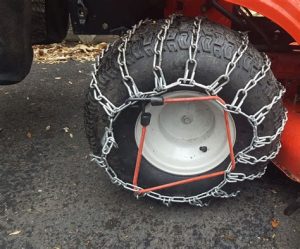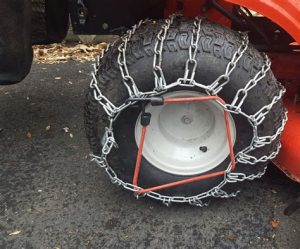Explore the pros and cons of chains versus other traction methods, factors for installation, and a detailed step-by-step guide for optimal performance.When it comes to enhancing traction for your tractor, choosing the right method can make all the difference in performance and safety. In this blog post, we’ll explore the pros and cons of tire chains compared to other traction solutions, providing you with a comprehensive overview of each option. From the unique benefits of chains to alternative methods such as tire studs or fluid ballast, we will help you navigate the key factors to consider before installation. Whether you’re working on icy roads or rugged fields, understanding these options will ensure you make an informed decision that best suits your needs. We’ll also walk you through a step-by-step installation guide for chains, culminating in a thorough performance comparison to help you determine the ideal traction method for your tractor. Let’s dive in!
Chains: Benefits and drawbacks
When it comes to enhancing the traction of tractor tires, many farmers and operators consider using chains. Chains can provide significant benefits but also come with certain drawbacks that must be evaluated carefully.
One of the primary benefits of using chains is their ability to improve the grip on soft or slippery surfaces. This is particularly important during winter months or in muddy conditions, where standard tires may struggle to provide adequate traction. Additionally, chains can help save time and resources by preventing getting stuck in difficult terrains, allowing for uninterrupted workflow.
However, there are also notable drawbacks to chains. For instance, they can lead to increased tire wear and may cause damage to the surface of the field if used on hard terrain. Furthermore, chains can be challenging to install and remove and may require additional maintenance during their use. Understanding both the benefits and drawbacks is essential before deciding whether to invest in tire chains.
Other Traction Methods: Comparison
When it comes to enhancing traction for tractor tires, several methods are available, each with its own advantages and disadvantages. Let’s delve into a comparison of chains and other traction methods to help you make an informed decision.
1. Tire Chains: Tire chains are one of the most traditional and effective methods for improving traction on slippery surfaces. They work by creating extra grip and are particularly useful in snowy or icy conditions. However, they can be cumbersome to install and remove, and can potentially cause damage to the tires and roads if not properly fitted.
2. Wheel Weights: Another option for enhancing traction is the use of wheel weights. This method involves adding significant weight to the tractor’s wheels, which increases downforce and enhances traction. While wheel weights are permanent and do not require installation like chains, they can make maneuvering more difficult and may add to fuel consumption.
3. Liquid Ballast: Filling tires with liquid ballast, such as water or calcium chloride, is a common way to improve traction. This method increases the weight of the tire, helping the tractor stay grounded. However, it may also lead to tire wear over time and can pose a risk if there is a puncture, as the liquid can leak out.
4. Tire Treads: Utilizing tires with specialized treads designed for traction can also be an effective approach. While more expensive than traditional tire options, they eliminate the need for additional traction methods like chains but may not offer the same performance on extreme surfaces.
| Traction Method | Pros | Cons |
|---|---|---|
| Tire Chains | Excellent grip, Ideal for ice/snow | Time-consuming installation, Possible road damage |
| Wheel Weights | Increased downforce, Permanent solution | Can affect maneuverability, Higher fuel consumption |
| Liquid Ballast | Improved ground control | Risk of leaks, Potential tire damage |
| Tire Treads | No additional installation required | Higher initial cost, Limited performance in extreme conditions |
In conclusion, when considering traction methods for your tractor tires, it is essential to weigh the benefits and drawbacks of each method. Your choice will depend on the specific conditions in which you operate, your budget, and maintenance preferences.
Factors to Consider Before Installation
When it comes to improving traction for your tractor tires, one of the most important decisions you’ll make is whether to use chains or other traction methods. Before diving into installation, several critical factors should be considered to ensure you choose the right option for your needs.
First and foremost, evaluate the type of terrain you will be working in. For instance, if you frequently navigate through muddy, slippery, or hilly areas, chains may provide the necessary grip to prevent slippage. On the other hand, rubber or polyurethane traction mats might be more effective in softer terrains without causing damage to the ground.
Another significant factor is your tractor’s specifications. Ensure that any traction method you consider is compatible with your tractor’s tire size and type. Additionally, consider the installation process; some options may require more time or tools than others. Maintenance is also vital—ensure you choose a method that you can maintain easily throughout your tractor’s operational life.
| Factor | Chains | Other Methods |
|---|---|---|
| Terrain Type | Excellent for muddy/hilly | Better for softer surfaces |
| Installation Ease | Moderate | Variable |
| Maintenance | Requires regular checks | Generally low maintenance |
Step-by-Step Chain Installation Process
Installing chains on your tractor tires is a straightforward process, but it requires attention to detail to ensure safety and performance. Follow these steps to properly install tire chains and improve traction.
- Tractor tires equipped with the correct size chains
- Protective gloves
- Adjustable wrench
- Tape measure
Park the tractor on a flat, stable surface and turn off the engine. Engage the parking brake to prevent any movement. This will provide a safe environment to work in.
Unroll the chains and lay them flat next to the tractor tire. Ensure there are no twists or kinks in the chains, as this could affect their performance.
Carefully place the chains over the top of the tire, making sure they are centered. Drape the chains evenly down each side of the tire.
Start from the inside of the tire and work outward, bringing the ends of the chains together. Attach the chain ends using the provided fasteners, making sure they are tight enough to prevent slipping but not so tight that they hinder tire movement.
Once the chains are secured, check for any slack. Adjust them as necessary, ensuring that they fit snugly against the tire tread. This is critical for maintaining proper traction while operating the tractor.
Finally, take a short test drive at a low speed. This allows you to see if the chains shift and ensures everything is secure. Listen for any unusual sounds or vibrations that might indicate a problem with the chain installation.
Performance Comparison: Chains vs Other Methods
When it comes to enhancing the traction of tractor tires, tire chains and other traction methods are often considered. Each method boasts unique benefits and potential drawbacks that can affect the overall performance during use. Understanding these differences is crucial for making an informed decision about which traction method to utilize, depending on the terrain and conditions faced.
Tire chains are renowned for their exceptional grip on icy or snowy surfaces. Compared to other methods, they provide superior performance under extreme weather conditions. By distributing the weight of the tractor more evenly and increasing the surface area in contact with the ground, chains significantly reduce slippage, thereby increasing safety and efficiency in work processes.
On the other hand, alternatives such as tire socks, foam fill, or liquid ballast can also offer traction benefits but come with different implications. For example, tire socks are lighter and easier to install, but their performance is often not as strong in extreme conditions compared to chains. Moreover, while foam fill provides excellent stability, it does not enhance traction in the same way as chains.
Frequently Asked Questions
What are the main benefits of using chains on tractor tires?
Chains provide enhanced traction on icy or muddy surfaces, improve stability, and can prevent slipping, making them ideal for challenging conditions.
How do tire chains compare to other traction methods?
While tire chains offer superior grip in snowy or muddy conditions, alternatives like studded tires provide a smoother ride and better performance on dry surfaces.
What are the installation steps for tractor tire chains?
To install tire chains, first park the tractor on a flat surface, lay the chains beside the tire, drape the chains over the tire, and then secure them tightly while checking for proper tension.
Are there specific types of chains recommended for different types of tractor tires?
Yes, there are various types of chains, such as cross chains, ladder chains, and diamond chains, each designed for different tire sizes and applications.
What maintenance is required for tire chains?
Regularly inspect the chains for wear and tear, clean them to remove dirt and ice, and lubricate them to prevent rust and ensure optimal performance.
Can tire chains be used on all types of tractor tires?
While most agricultural tires can accommodate chains, it’s important to check the tire manufacturer’s guidelines to ensure compatibility.
What should I consider when choosing between chains and other traction methods?
Consider the terrain you’ll be operating in, the typical weather conditions, and the specific tasks you’ll be performing to determine the most suitable traction method.





